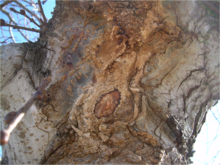Slime flux
| Slime flux | |
|---|---|

Slime flux on a Camperdown Elm caused by Pectobacterium carotovorum. Note the ooze (dark ring in the center) and the discoloration of the bark.
|
|
| Causal agents | Bacteria (Brevundimonas bullata, Paracoccus alcaliphilus, P. marcusii and Luteimonas aestuarii, andPectobacterium carotovorum) |
| Hosts | Trees (elm, cottonwood, poplar, boxelder, ash, aspen, fruitless mulberry and oak) |
| EPPO Code | ERWICA |
Slime flux is a bacterial disease of certain trees, primarily elm, cottonwood, poplar, boxelder, ash, aspen, fruitless mulberry and oak. A wound to the bark, caused by pruning, insects, poor branch angles or natural cracks and splits, causes sap to ooze from the wound. Bacteria may infect this sap causing it to darken and stain the bark, eventually taking on a foamy appearance and unpleasant odor. This slimy ooze becomes toxic to the bark and eats into the tree. Additionally, the fermented sap attracts insects like flies, ants, and maggots.
There is no cure, but the bark of a tree is like skin. The wound should be disinfected with rubbing alcohol or a household bleach solution of one part bleach to nine parts water. The excess sap should be wiped from the tree to discourage hungry insects. With prompt and continuous treatment, the tree should survive. In the forest, practices that minimize wounding will reduce the spread of this disease. For urban trees, maintaining vigorous, healthy growing conditions (through watering, mulching around the base and adding compost to the drip line) and avoiding wounds will reduce the probability that trees will be affected by this disease. Removing bark from the affected area will reduce damage to an individual tree.
Slime flux or more commonly known as Wet wood is a seepage of the wood that is unseen by the human eye. The seepage is typically a sour smell that comes from the trunk of the tree.
The slime flux disease causes a constant odor, Bleeding Cankers on the base of the tree. Slime flux will not kill a tree but is merely a sign that there has been an earlier injury. In some cases as the outer wound calluses over and the internal methane production decreases, the slime flux may stop in a year or two. In other cases slime flux may reoccur year after year.
...
Wikipedia
